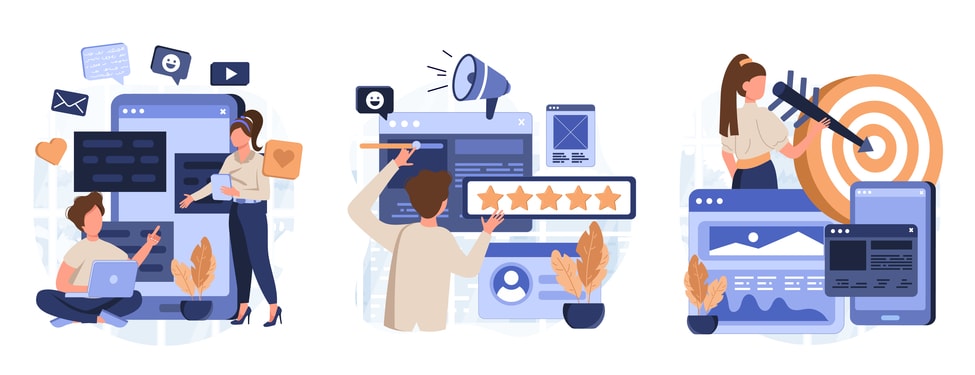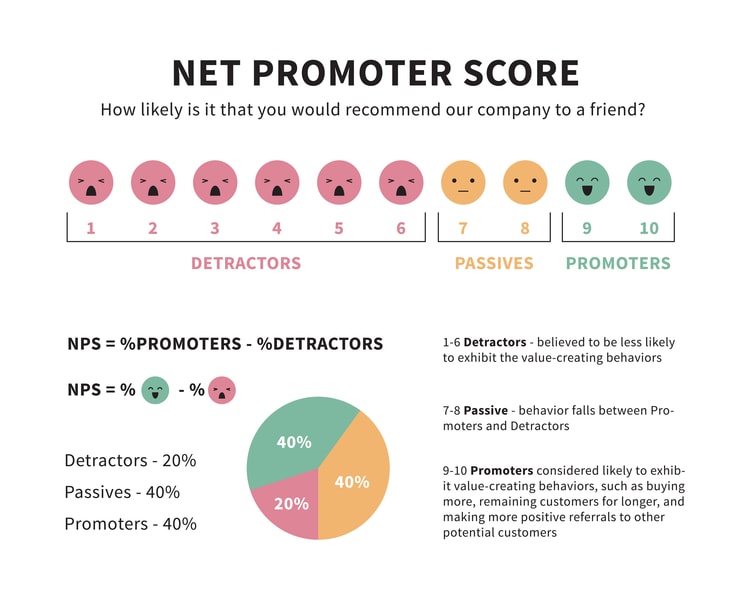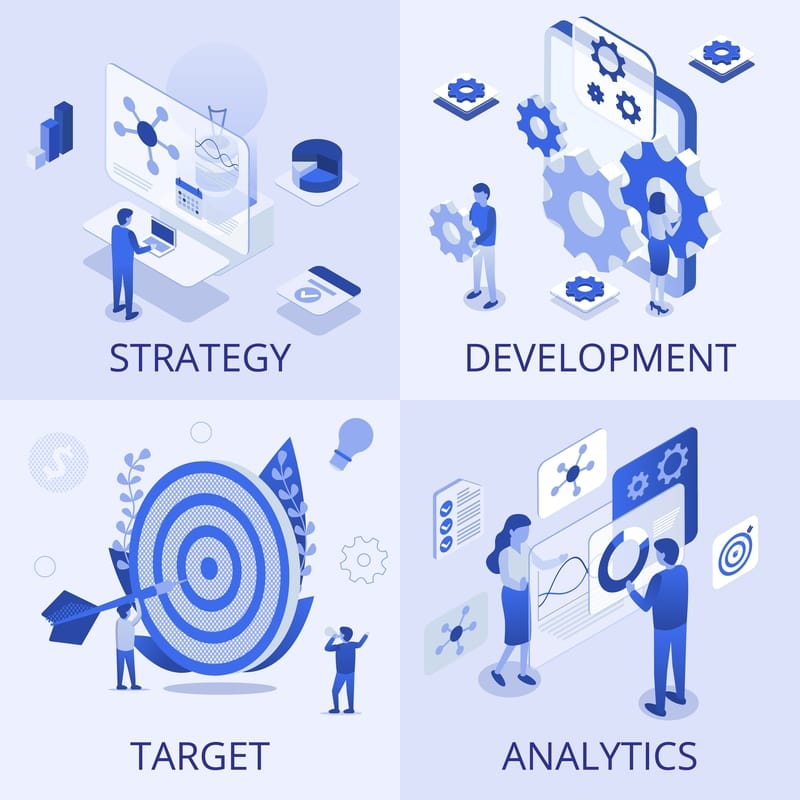It’s easy to think that being customer-centric simply means putting customers first. However, there’s a lot more to it than that. Being truly customer-centric means having the right mindset from the roots of your business. It’s about making sure that every decision you make is driven by the needs and wants of your customers.
Customer centricity is all about creating a great customer experience. This means going above and beyond simply meeting customer expectations. It’s about making sure that every interaction a customer has with your business is positive, memorable, and valuable.
Creating a customer-centric business isn’t easy. It takes a lot of hard work and dedication. But it’s worth it. Customer-centric businesses are more successful and more profitable than their competition.
You’re in for a long haul since we’ll be discussing quite a bit on the topic of customer-centricity and how it impacts an organization and its interaction with prospective customers to create long-term relationships.
What is Customer Centricity and How Does It Figure Into a Customer-Centric Approach?
At its simplest, customer-centricity is all about making your customers the central focus of your business. It’s about understanding their needs and desires and then creating a unique customer experience that meets those needs.
In today’s competitive landscape, businesses can no longer afford to operate without a customer-centric approach. Customers have more choices than ever before, and they’re not afraid to use them. If they’re not happy with their current provider, they’ll simply switch to another one that offers a better experience.
The key to success is to create a customer experience that is so exceptional, so memorable, and so valuable that your customers will be happy to stay with you, even if there are cheaper or easier options available.
Enhancing Business Agility Through Customer-Centric Solutions
Organizations today are under more pressure than ever to be customer-centric since it can have a profound impact on an organization’s bottom line. Satisfied customers lead to increased loyalty and repeat business, while also providing valuable customer feedback that can help businesses improve their offerings. In fact, studies have shown that customer-centric companies are 60% more profitable than their less customer-focused counterparts.
Clearly, customer centricity is essential for any organization that wants to thrive in today’s competitive landscape. But what does it take to be truly customer-centric? Below are three key components:
1. Listening to customers
It’s important to listen to what customers are saying, both directly and indirectly. Customer observation can be done through surveys, focus groups, social media monitoring, and other research methods.
2. Putting customers first
Once you know what customers want, it’s important to align your products, services, and processes to meet those needs. This means making customer satisfaction a priority at all levels of the organization.
3. Constantly improving
Even the most customer-centric organizations need to continuously strive to improve their offerings. This can be done by soliciting feedback on a regular basis and using that feedback to make improvements.
By following these three steps, organizations can position themselves for success in today’s customer-centric world.
The Challenges To Becoming Customer-Centric in Mind and Business
There’s no question that businesses need to be focused on their customers if they want to stay relevant and thrive in today’s marketplace. However, becoming truly customer-centric can be easier said than done. Here are some of the biggest challenges businesses face when seeking to become more customer-centric:
1. Defining what “customer-centricity” means for your business
The term “customer-centricity” means different things to different businesses. For some, it may simply mean ensuring that customers are always happy with the product or service they receive. For others, it may mean going above and beyond to provide an exceptional customer experience at every touchpoint. It’s important for businesses to take the time to define what customer-centricity means for them before they can start making changes.
2. Making the shift from product-centric to customer-centric
Many businesses are still very product-centric in their approach, which means they’re focused on selling as many products or services as possible without really taking the time to understand their customers’ needs and desires. To become truly customer-centric, businesses need to make a shift in their thinking and start putting the customer first in everything they do.
3. Identifying customer needs and wants
One of the biggest challenges businesses face when trying to become more customer-centric is understanding what their customers really need and want. This can be difficult to do if you don’t have a good system in place for collecting customer feedback. consider conducting surveys, interviews, or focus groups with your target market to get a better understanding of their needs and wants.
4. Delivering on customer expectations
One of the most important aspects of becoming customer-centric is delivering on the promises you make to your customers. If you say you’re going to provide an exceptional customer experience, you need to make sure you deliver on that promise.
5. Sustaining the changes
The final challenge businesses face when trying to become more customer-centric is sustaining the changes they’ve made. It’s not enough to make changes and then go back to business as usual. You need to find ways to keep the momentum going and make sure the changes you’ve made are here to stay.
These are just some of the challenges businesses face when trying to become more customer-centric. It’s not an easy task, but it’s one that’s worth undertaking if you want to improve your business and your bottom line.
Do you want to achieve customer centricity and success for your company?
What Does a Customer-Centric Enterprise Look Like?
A customer-centric business is one that puts its customer needs first. This type of business designs its products and services with the customer in mind and strives to provide a positive customer experience at every touchpoint.
A customer-centric model is also committed to meeting or exceeding customer expectations and works constantly to improve its offerings.
Some of the key features of a customer-centric company include:
1. A focus on the customer
A customer-centric business has a laser-like focus on its target market and knows its customers inside and out. This deep understanding of the customer through ample market research allows the company to anticipate their needs and design products and services that address them.
2. A customer-first mindset
Every decision made with a customer-focused mindset is based on what’s best for the customer. From product development and pricing to marketing and customer service, the customer always comes first.
3. An integrated approach
A customer-centric mindset takes an integrated approach to meeting its customers’ needs. All departments and employees are focused on providing exceptional customer experience, and everyone understands how their work contributes to this goal.
4. A commitment to excellence
A customer-centric strategy is committed to providing the best possible products and services to its consumers. It constantly strives to improve its offerings, develop solutions in line with a customer’s perspective, and deliver exceptional value.
5. A focus on the customer journey
A customer-centric model designs every aspect of the customer journey with the goal of making it as easy and enjoyable as possible. Every touchpoint is carefully considered, and the overall journey is planned out in advance to ensure customer success.
6. A culture of customer service
Customer-centric experiences involve a culture of customer service that starts at the top and permeates throughout the organization. Everyone understands the importance of delivering a great experience, and they work together to make it happen. This ensures customer retention as well as parallel business growth.
7. A focus on retention
A customer-centric business understands that it costs less to keep a current customer than to acquire a new one. As such, it focuses on retaining its customers and providing them with the best possible experience.
8. A focus on growth
A customer-centric organization is always looking for ways to grow its customer base and expand its reach. It invests in marketing and sales initiatives that attract new customers and works to convert them into loyal fans.
9. A data-driven approach
A customer-centric business relies on data to drive its decision-making. It uses available customer data to better understand its audience and their needs and to continuously improve its products and services.
10. An agile mindset
Customer-centric businesses are agile and able to rapidly respond to changes in the market or their customers’ needs. It’s constantly innovating and adapting its offerings to stay ahead of the competition.
How Deeply Does the Impact of Customer Centricity Affect Business Decisions?
The impact of customer centricity has been felt across all industries as companies race to keep up with the competition. In order to remain relevant and attract new customers, businesses must focus on putting the customer first in everything they do.
This means making decisions based on what is best for the customer, rather than what is best for the company. It can be a difficult balancing act, but it is one that is essential for survival in today’s economy.
Some companies have been able to make the shift to a customer-centric model and have seen great success as a result. Others have struggled, and many have failed. The key to success is understanding how deeply customer-centricity affects business decisions and then making the necessary changes to ensure that the customer is always put first.
Measuring Customer-Centricity as a Stepping Stone To Customer Success
There are a few key ways to measure customer-centricity:
1. Customer feedback
This can be in the form of surveys, interviews, or focus groups. It’s important to collect feedback on a regular basis so you can track progress and identify areas for improvement.
2. First contact resolution rates
This metric measures the percentage of customer inquiries that are resolved on the first contact. It’s a good way to gauge how efficiently your customer service team is handling inquiries.
3. Net Promoter Score (NPS)
This is a customer loyalty metric that measures how likely customers are to recommend your company to others. NPS can be a valuable indicator of customer-centricity.
4. Customer retention rates
This measures how well you keep your customers over time. A high retention rate is a good sign that your customers are happy and satisfied with your company.
5. Customer Lifetime Value (CLV)
This measures the total value that a customer brings to your company over their lifetime. CLV is a good way to gauge the long-term success of your customer relationships.
6. Employee satisfaction
This is an important metric to track because happy employees are more likely to provide great customer service. Higher employee satisfaction can lead to higher customer satisfaction levels.
7. Average Handle Time (AHT)
AHT is the average amount of time it takes for customer service representatives to resolve an inquiry. This metric can be a good indicator of how efficiently your customer service team is working.
These are just a few of the ways you can measure customer-centricity. Ultimately, it’s important to track multiple metrics so you can get a well-rounded view of your company’s progress.
Propel your business growth with customer centricity!
What Are the Positive Impacts of Customer Centricity on a Business?
Considering that the customer is always king, more and more businesses are adopting a customer-centric approach, which puts the needs of the customer first and foremost. This shift can have a positive impact on the bottom line in a number of ways.
For one thing, happy customers are more likely to return and do business with you again. They’re also more likely to tell their friends and family about your company, which can help you attract new customers.
In addition, when you make an effort to understand and meet your customers’ needs, they’ll be more loyal to your brand and less likely to switch to a competitor. All of this can lead to increased sales and profits for your business.
Here are a few key benefits of giving greater focus to customer-centricity for a business.
Reduced Customer Churn Rates
A business that is customer-centric – one that makes decisions based on what is best for the customer – is more likely to have lower customer churn rates. Why? Because they have a deeper understanding of their customers and what they need.
They’re also able to act on actionable insights to improve the customer experience. As a result, customers are more satisfied and loyal, which leads to reduced churn. In other words, customer centricity is good for business – and it all starts with putting the customer first.
Increased Customer Satisfaction
Poor customer service is one of the main reasons why customers decide to take their business elsewhere. On the other hand, good customer service can be a key differentiator for businesses. When customers feel valued and appreciated, they are more likely to continue doing business with a company. Good customer service often leads to increased customer satisfaction, which can have a positive impact on a company’s bottom line. In today’s competitive market, businesses need to do everything they can to differentiate themselves from the competition. Providing excellent customer service is one way to do just that.
Increased Revenue and ROI
In a customer-centric culture, the customer is at the center of everything, from providing an exceptional customer experience at every touchpoint to working to build long-term customer relationships. This focused approach leads to increased revenue, as customers are more likely to stay with a company that provides a great customer experience. In addition, happy customers are more likely to recommend a company to their friends and family. So if you’re looking to increase revenue, creating a customer-centric culture should be at the top of your list.
Some Common Pitfalls To Avoid When Incorporating Customer Centricity
1. Becoming too obsessed with the customer’s needs
One of the most common mistakes businesses make when trying to incorporate a customer-centric approach is becoming too customer-obsessed. In other words, they become so focused on pleasing their customers that they lose sight of their own needs and goals.
This can lead to a number of problems, including making decisions that are not in the best interests of the business, sacrificing quality in order to keep prices low, and neglecting important aspects of the customer experience.
Ultimately, becoming too customer-obsessed can do more harm than good, and it is important to strike a balance between meeting customer needs and maintaining a healthy bottom line.
2. Basing business decisions on previous experience
All too often, businesses make the mistake of basing their decisions on profit-led data instead of customer data. This can lead to products and services that don’t meet customer needs or want, and in turn, results in lower sales and disappointed customers.
If you want to avoid making this mistake, always ensure that you are basing your decisions on customer data and not just on what you think will make the most money. Only by putting your customers first will you be able to create a successful and sustainable business.
3. Easing up on market research
Just because you know your product or service inside and out doesn’t mean your target market does too. Before you start talking to customers, it’s important to understand who they are, what they need, and how they like to be communicated with. This will help you craft an effective customer-centric approach from the outset.
The second mistake is to only do secondary research. While desk research is a great starting point, it can only tell you so much. The best way to get to know your target market is to talk to them directly. This means conducting primary research such as surveys, interviews, and focus groups.
The third mistake is to rely too heavily on qualitative data. While this type of data can be very insightful, it should always be used in conjunction with quantitative data such as sales figures and website traffic statistics. This will help you get a more well-rounded understanding of your target market.
Lastly, don’t make the mistake of thinking that market research is a one-time exercise. Your target market is always evolving, so it’s important to keep your finger on the pulse by regularly conducting research.
4. Investing in formalities until the initial purchase
A customer-centric approach is a key element of success for any business, yet it’s often one of the first things to fall by the wayside once a sale has been made. This is a mistake that can cost businesses dearly in the long run, as it ultimately leads to dissatisfied customers and lost repeat business.
The key to maintaining a customer-centric approach is to keep the lines of communication open at all times. This means promptly addressing any concerns or questions that may arise, and proactively reaching out on a regular basis to check-in and see how things are going.
By taking these simple steps, businesses can ensure that their customers always feel valued and appreciated – two essential ingredients for maintaining a strong, long-lasting relationship.
Final Thoughts on the Impact of Customer Centricity on Businesses
The impact of customer centricity cannot be understated. In a recent study, 78% of respondents said they would pay more for a product or service if it ensured a great customer experience.
What’s more, 89% of customers said they would switch to a competitor after a poor customer experience. Given these statistics, it’s clear that businesses need to embrace the concept of customer centricity in order to stay competitive.
By putting the customer first, businesses can increase loyalty and repeat business, while also generating word-of-mouth marketing. In other words, customer-centricity is not only good for customers, but it’s also good for business. When done right, everybody wins.
There are many ways to become more customer-centric, but it all starts with understanding your customers better. Take the time to get to know them on a deep level, and you’ll be well on your way to creating lasting relationships built on trust and mutual respect. Your bottom line will thank you for it.
If you’re looking for a stepping stone to help propel you into boosting your business growth, Growth Hackers is the growth agency where you’ll find the ideal business solution. Our certified team of individuals works alongside your business goals to ensure customer loyalty and build revenue in the long run.
Going beyond just consulting or coaching, we execute strategies that generate leads, increase organic traffic, strengthen your brand, acquire potential consumers, and more. Reach out to Growth Hackers today to get started in establishing your brand.










